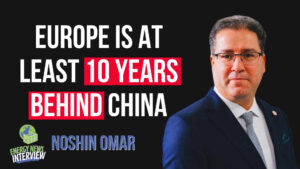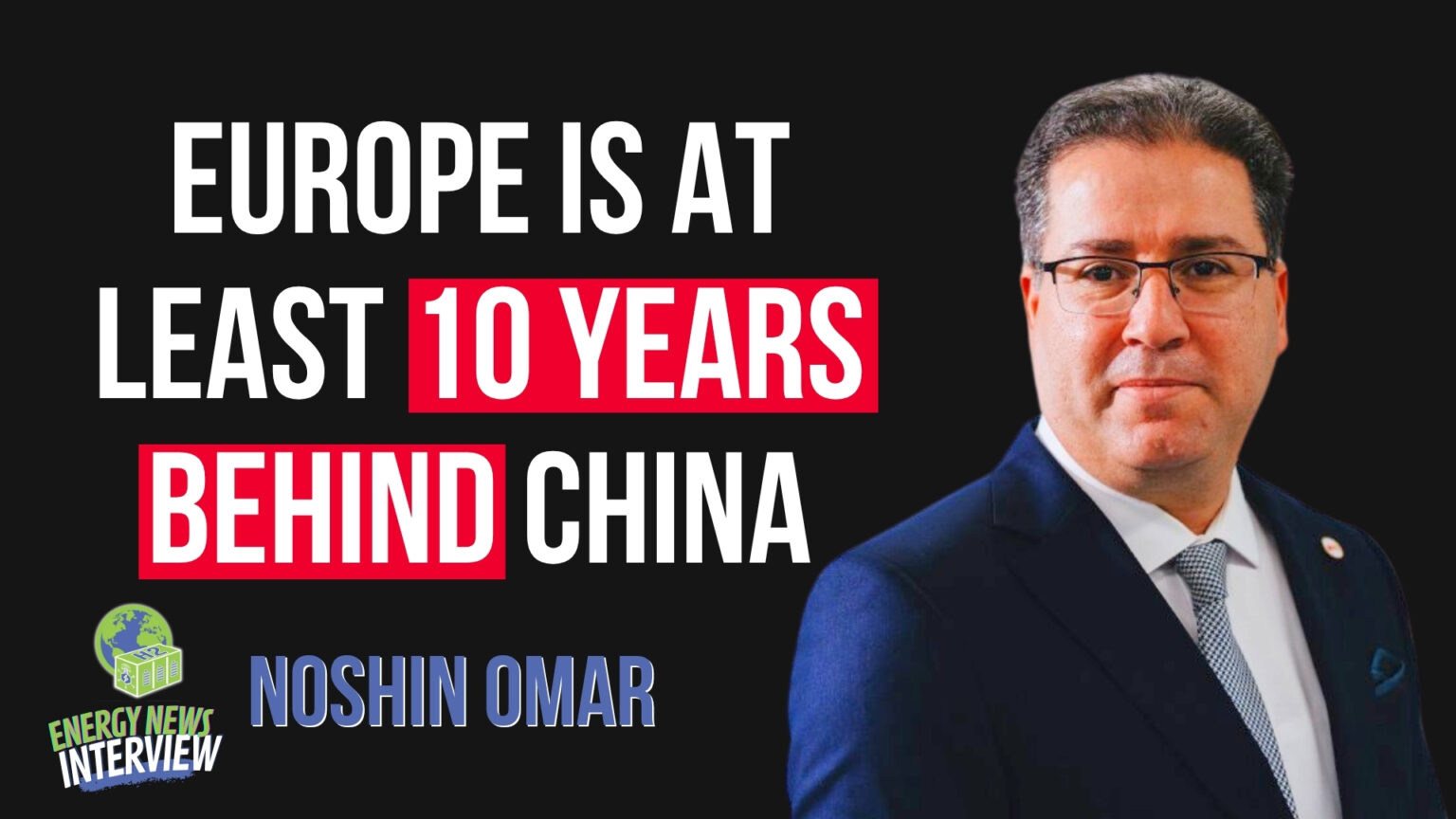The brutal truth about Europe’s battery ambitions hit me during a conversation in Sarajevo with Noshin Omar, the founder of AVESTA Holding. While Chinese battery startups surge from zero to billion-dollar valuations in just three years, Europe’s most innovative battery manufacturers are struggling to secure even scraps of capital and are drowning in permit applications.
WATCH THE FULL INTERVIEW HERE
Omar didn’t mince words: “Unfortunately, we in Europe are not risk-minded to support startups, to support good ideas. While in the US, in China, they are.”
This isn’t just another complaint about regulatory burden. This is an existential crisis playing out in real-time as Europe watches its energy independence slip away.
The Only Game in Town
AVESTA is doing something remarkable and almost absurd in its rarity: they’re the only company producing lithium metal anodes in Europe. The only one. In Japan, Korea, and America, this technology has existed “for a while.” But in Europe? AVESTA stands alone.
Think about that for a moment. As the continent races toward electrification, as politicians promise millions of EVs and renewable energy storage, Europe has exactly one supplier developing the critical lithium metal technology needed for next-generation solid-state batteries.
“We are fully dedicated to optimization of the processes behind that and to scale that up accordingly to make it much more cost-efficient,” Omar explained. “But we are also still not at the mass scale of serious production, and that’s something which we are working on it day and night.”
Day and night. One company. One European supplier.
The Recycling Crisis Nobody Wants to Talk About
While the conference Omar attended buzzed with excitement about new battery technologies, recycling barely got a mention. Yet here’s the reality check: 100,000 tons of end-of-life batteries will need to be recycled in the coming years. European regulations mandate that 5% of new batteries must contain recycled materials.
Europe is “quite very active” in recycling nickel and cobalt. But for lithium-iron-phosphate batteries? “Europe is already lagging. At least 10 years are lacking behind compared to the Chinese.”
A full decade.
Omar was in Bosnia exploring opportunities for the first lithium-iron-phosphate recycling plant in the region. Why Bosnia? Because the economics actually work when you consider the total cost of ownership—something most European buyers conveniently ignore when they chase the lowest upfront price from Asian suppliers.
“Often customers are looking to the quotation pricing but without neglecting the insurance cost, transportation cost, the risk cost, debt interest cost, and so on,” Omar said. “If you take them all, you conclude that producing batteries or recycling batteries in a country like Bosnia will be much more attractive than buying them actually from China.”
The Solid-State Gamble
AVESTA is betting big on solid-state batteries with lithium metal anodes—technology that could double the range of electric vehicles and eliminate the obsessive focus on fast charging infrastructure.
“When there is no fast charging, there will also be less stress on the grid, and that’s what we are all aiming for,” Omar explained. It’s an elegant solution that solves multiple problems at once: range anxiety, grid stability, and charging infrastructure demands.
The company plans to bring solid-state batteries to market by 2030 from their facilities in Bulgaria, “fully controlled by a European supply chain.” Not just assembled in Europe. Controlled by Europe.
But here’s where the European handicap becomes painfully clear. While Omar works toward 2030, Chinese competitors with aggressive funding and streamlined regulations are moving faster. Much faster.
The Regulatory Stranglehold
When I asked Omar about the toughest challenge AVESTA faces, the answer was immediate: “Long permit for giga factories and the entire European Union.”
Not technology. Not competition. Not even financing, though that’s clearly a massive issue.
Permits.
While Chinese battery startups scale from concept to gigafactory in record time, European innovators are trapped in bureaucratic purgatory, waiting for permission to build the infrastructure Europe desperately needs.
Omar praised the European Commission’s battery passport initiative—a transparency and lifecycle tracking system—but added a damning caveat: “From my point of view, it came quite late and it is still not aggressive enough.”
Even Europe’s regulations, designed to give it a competitive advantage through sustainability standards, aren’t ambitious enough and arrived too late.
The Coming Supply Shock
China’s restrictions on graphite and lithium exports, coming into force on November 8th, will “make the recycling of lithium-iron-phosphate much more attractive,” according to Omar. Translation: Europe is about to learn a hard lesson about supply chain vulnerability.
For years, European manufacturers chased cheap Asian quotes while ignoring the hidden costs of distant supply chains, geopolitical risk, and environmental externalities. Now those chickens are coming home to roost.
AVESTA is positioning for this reality with a three-pillar model: production, recycling, and services. They’re building battery production facilities (including a new plant in Mardin, Turkey with 1-3 GWh annual capacity), establishing recycling operations across the Balkans, and creating an integrated supply chain.
It’s exactly what Europe needs. But it’s happening at European speed—which is to say, too slowly.
The Mindset Problem
The real issue isn’t technology. European engineers and researchers are world-class. AVESTA’s lithium metal production proves that.
The issue isn’t even regulations alone, though they’re certainly choking innovation.
The core problem is mindset. Risk appetite. The willingness to bet big on breakthrough technologies.
“Unfortunately, we don’t have such of mindset of investors and financial institutions,” Omar said with evident frustration.
In China, a promising battery startup can access capital, scale production, and capture market share at breathtaking speed. In Europe, that same company would still be filling out environmental impact assessments while Chinese competitors eat their lunch.
What Needs to Change
First, Europe needs emergency fast-tracking for strategic battery infrastructure. Not in five years. Now. The permit process for gigafactories should be measured in months, not years.
Second, European investors and financial institutions need to embrace productive risk. Not cryptocurrency gambling or fintech speculation—real industrial investment in critical technologies. The kind of investment that built Europe’s industrial base in the first place.
Third, European customers—from automakers to energy companies—need to look beyond the price on the quote. Total cost of ownership, supply chain resilience, and strategic independence aren’t externalities. They’re core considerations.
Fourth, recycling infrastructure needs the same urgency as battery production. Omar’s pursuit of lithium-iron-phosphate recycling in Bosnia shouldn’t be a lonely quest. It should be a continent-wide priority with substantial public and private support.
The Fork in the Road
Europe faces a choice. It can continue sleepwalking into battery dependence while congratulating itself on rigorous environmental standards and prudent financial oversight. Or it can wake up to the reality that the global battery industry is being reshaped right now, and Europe is barely in the game.
Companies like AVESTA are fighting to give Europe a chance. They’re developing critical technologies, building European supply chains, and creating the infrastructure for energy independence.
But they’re fighting with one hand tied behind their backs by regulatory inertia and capital scarcity while competitors sprint ahead unencumbered.
Omar’s vision of solid-state batteries rolling off European production lines by 2030, powered by European supply chains and recycled European materials, is achievable. But only if Europe decides it actually wants to win.
Right now, that decision remains painfully uncertain.
The question isn’t whether Europe can build a competitive battery industry. AVESTA proves it can. The question is whether Europe will muster the courage, speed, and risk appetite to actually do it.
Time is running out. And in the battery industry, coming in second place means not competing at all.

